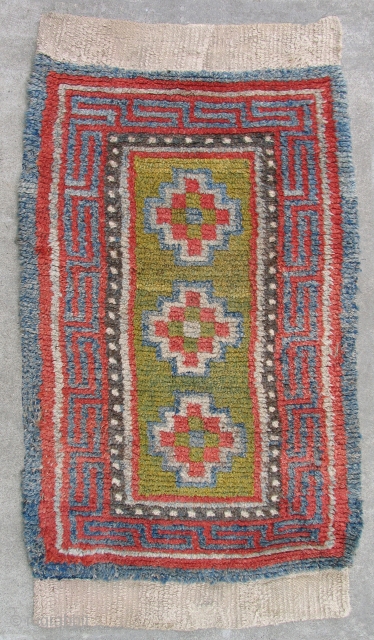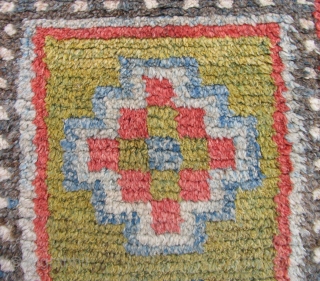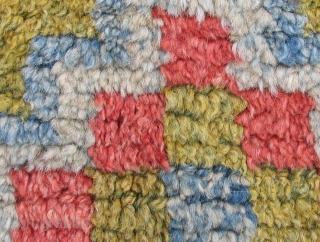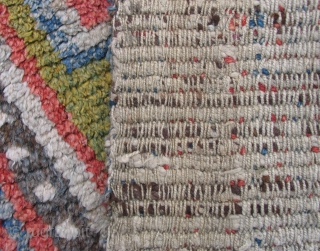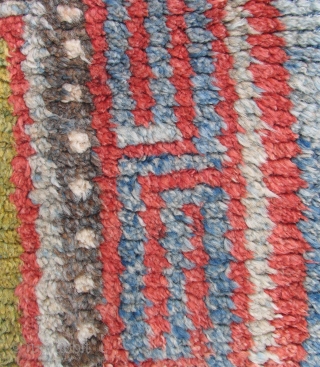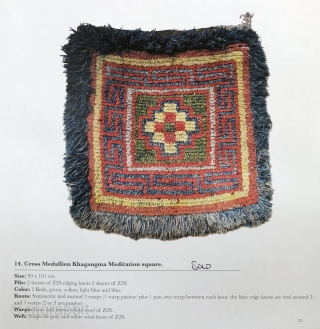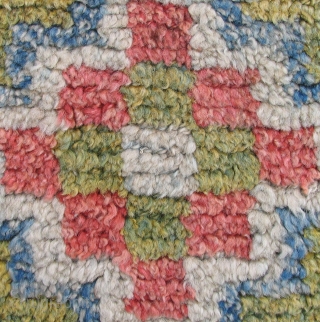Back
Tibetan three medallion rug. Luminous and lush with a delicate subtle, palette - the rug is old. a so-called Wangden type with the warp predominant back. The knots were tied over every other warp pair - a result of the thick wefting material being pulled straight through each shed making only every other warp available for knotting. This is likely a very early weaving technique in the region and is diagnostic of this type of Tibetan rug. Related structures are also seen in some other Central Asian nomad weavings - usually in strip woven pieces and some kinds of tent bands with supplemental knotting. This rug reportedly came out of Tibet in the late 80's around the time Tibet opened up to the West. i was recently informed by the person who originally purchased it in Kathmandu that it was the very first rug of the type to appear on the market in Kathmandu. It went through the hands of two dealers in the Bay Area before i brought it in the early 90's. i have owned it ever since. In all this time i have not seen another piece in this design with this three medallion format - or with such a soft and luminous color palette. There is square mat in this design that was published In Sam Coad's exhibition catalogue 'Wanden/Style" as plate 14 ( see image below). It also has the stepped diamond motif and similar, though not exactly the same coloration. a few other square shaped mats are known in this design, but i know of none with in this rectangular format with three stepped diamond medallions. Sam's #14 has a yellow in it and deeper, somewhat less luminous color tones. My piece has a softer more pleasing palette and a kind of "inner glow" to it that makes the piece very appealing in the flesh. It is quite different from Sam's piece in this respect. Interestingly, there are no true whites in this rug except in the spots of the inner border. All other white looking colors are - upon close examination - a very pale, light blue. Even the inner border that appears brown is an indigo over-dye of variegated light brown wool. Sections of an old pile-like Tibetan blanket were attached to the ends of the rug when it came out of Tibet. It has had some damage that was stabilized in different episodes over the years with old cloth in places on the back. Nonetheless, it looks great on the front and is not fragile. It has soft and lush Tibetan wool pile. This is a really good rug with a special something that sets it apart from others. One of my personal all time favorites. Size: 65 x 34 inches.
price:
Inquire
- Home
- Antique Rugs by Region
- Category
- Profiles
- Post Items Free
- Albums
- Benaki Museum of Islamic Art
- Budapest: Ottoman Carpets
- Gulbenkian Museum
- Islamic Carpets. Brooklyn
- Islamic Textiles. Brooklyn
- Konya Museum: Rugs
- MKG, Hamburg
- MMA: Caucasian Carpets
- MMA: Mamluk Carpets
- MMA: Mughal Indian Carpets
- MMA: Ottoman Carpets
- MMA: Safavid Persian Carpets
- MMA: Turkmen Rugs
- McCoy Jones Kilims
- Ottoman textiles. Met
- Philadelphia Museum
- Rugs and Carpets: Berlin
- Seljuqs at the Met
- TIEM, Istanbul: Carpets
- V&A: Classical Carpets
- Vakiflar Carpets: Istanbul
- Baluch Rugs: Indianapolis
- Gallery Exhibitions
- Jaf an Exhibition
- Alberto Levi Gallery
- Andean Textile
- Christie's London: 2016
- Francesca Galloway
- HALI at 40
- ICOC Washington, DC 2018
- Jajims of the Shahsavan
- London Islamic Week April, 2018
- Mongolian Felts
- Navajo Rugs: JB Moore
- Persian Piled Weavings
- SF Tribal & Textile Art Show 2020
- SF Tribal 2019
- Sotheby's: C. Alexander
- Turkish Prayer Rugs
- Turkmen Main Carpets ICOC 2007








